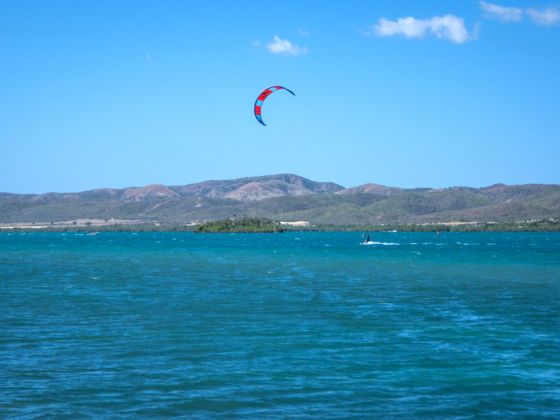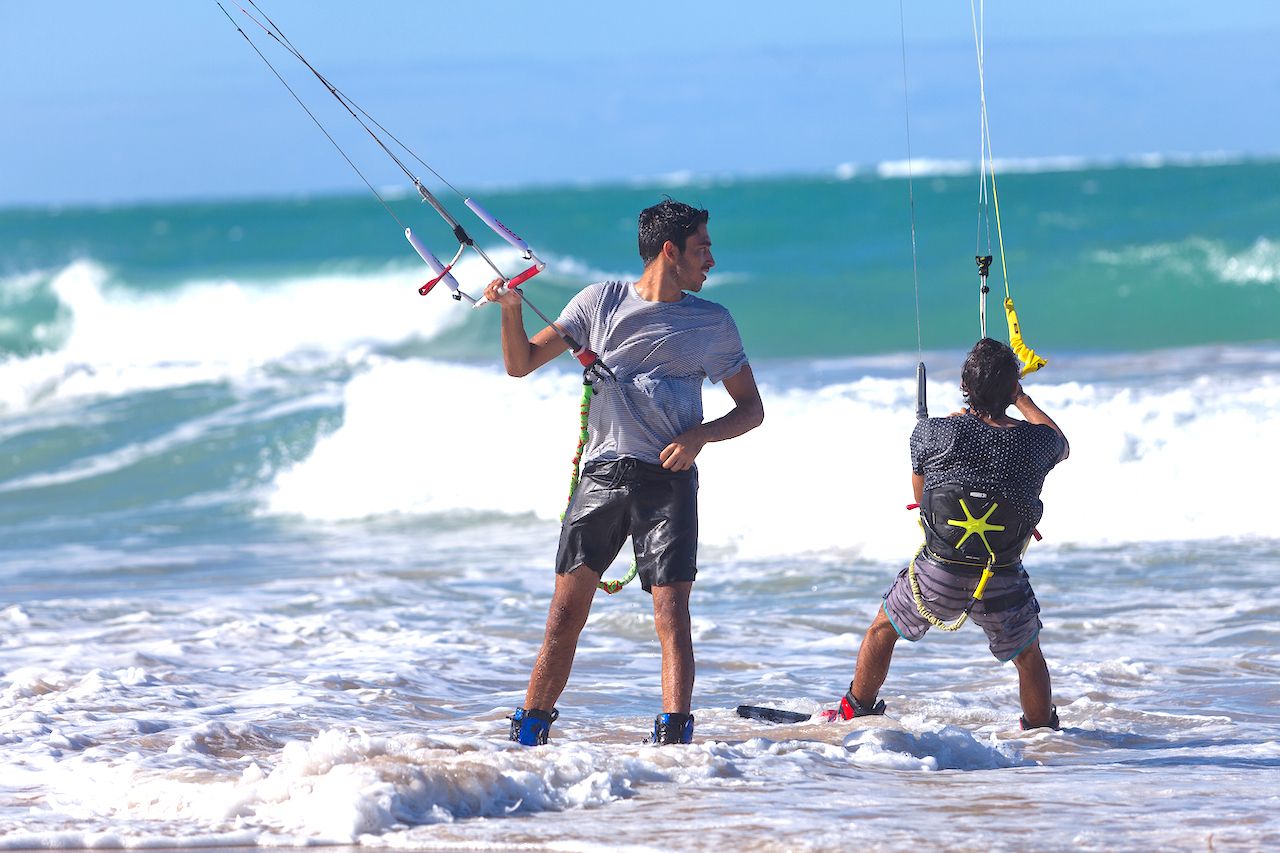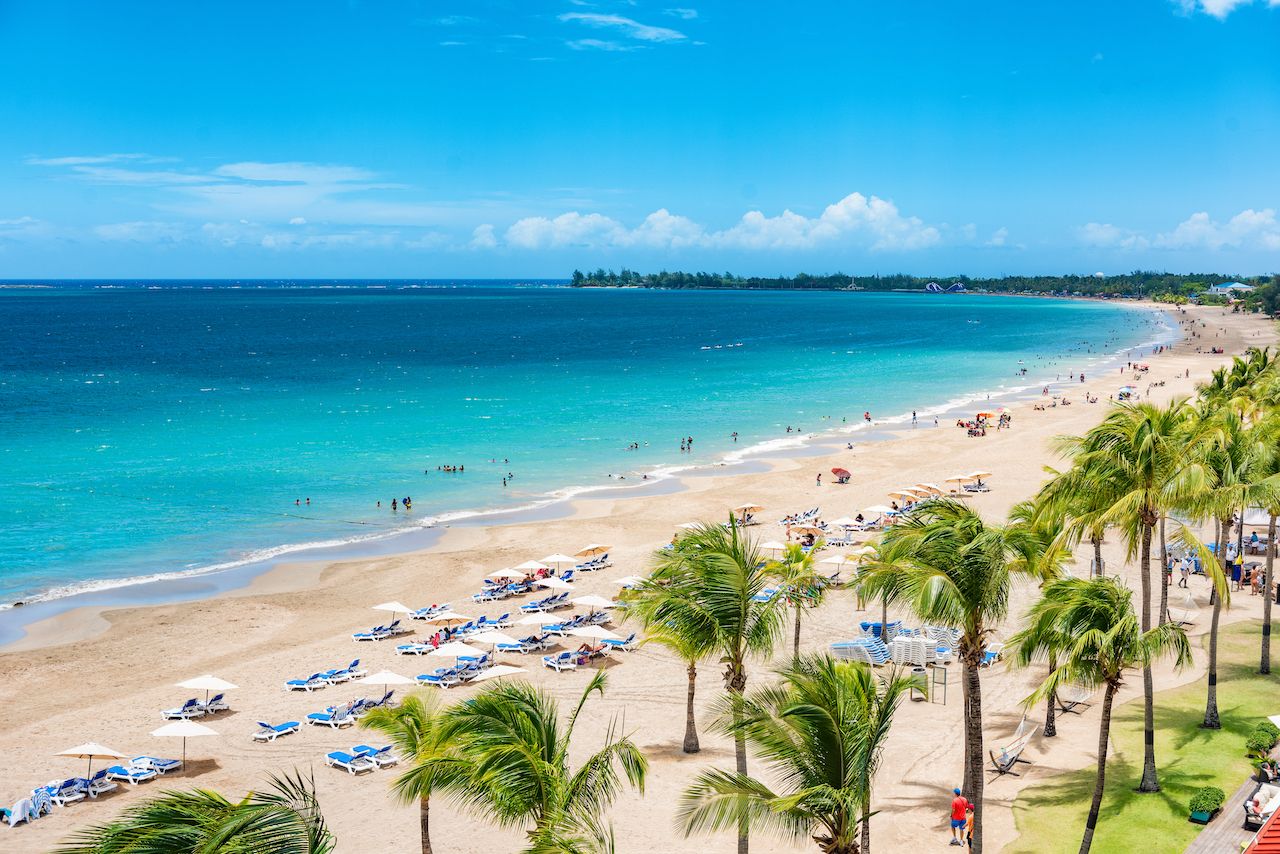The world is full of great places to kitesurf. But if you want an ideal location to start this sport, Puerto Rico is the place. It’s a beautiful spot that’s easy to get to and has steady winds for most of the year. The water-sports culture there also means you have several options of where to go and established shops providing lessons, gear, and instructors. In fact, you’ll find plenty of kitesurfing outfits right in the capital, San Juan. If your time is limited, San Juan is a solid kitesurf rookie destination — but for a real beach vibe, you should travel beyond the city. Here’s what you need to know to have the best experience kitesurfing in Puerto Rico.

Why Puerto Rico Is the Perfect Place to Learn to Kitesurf
Lesson timing — because wind (but not too much wind) is critical

Photo: Infinite_Eye/Shutterstock
If you’ve never done any kiting before, take a lesson from a professional. Kitesurfing requires a fair amount of gear, all of which will be new to most people. Even if you’re confident with other water sports, it’s worth getting some instruction. We recommend lessons from the incredibly friendly team at Goodwinds, located on beautiful Dorado Beach, a 45-minute drive from San Juan. The shop offers lessons and gear for everything from kitesurfing to e-foiling, as well as surf camps for kids every Saturday and Sunday.
Obviously, kitesurfing requires wind. But as a beginner, you don’t want too much wind, known as “nuking” in the sport’s parlance. It’s ideal to have a three-to-five-day spread when you can take lessons. Depending on conditions, you may be able to take lessons every day, or you may have to wait several days until it’s right. Even if the wind is calm, ask if you can test a smaller kite on the beach, because any time with the kite is beneficial.
It’s worth connecting with the shop you plan to use beforehand to let them know you’re coming for one or more lessons. They’ll know best and can check the conditions, suggest the right days, and communicate with you if things change.
What to expect from your first days in the surf

Photo: Tracy Vanderford/Shutterstock
Unless you’re in the top one percent of naturally gifted kiters or already have some experience, on day one you should expect to practice for two to three hours and shouldn’t expect to be on the board. A good instructor will take time to walk you through the equipment before you ever see a kite — in particular, the Control Bar and Chicken Loop — and guide you through kite terminology.
You’ll also practice “rigging up” — connecting the lines to the kite — and then your instructor will likely take the kite, get it up in the air, and pass it over to you. This is when it starts to get exciting. The instructor will guide you through some basic maneuvers so you can get a feel for the wind and how the kite responds to the control bar. You will certainly crash the kite on the beach a few times.
Once you’re more comfortable with the kite, you’ll probably get some drilling in, moving and stopping the kite at 10 o’clock, 11 o’clock, and — the key — 12 o’clock (directly above your head). Chances are you’ll start with a smaller kite around four meters, or 13 feet, in diameter. Once you get comfortable with this, you’ll move on to a bigger kite, one that you’re likely to use once you get out on the water.
The next step is “body dragging.” You’ll move out into the water with the kite, let your feet float behind you, and feel the kite pulling you through the water. Finally, on day two or three, depending on the length of your lessons and skills with the kite, you’ll graduate to the board. Most shops will send someone out on a boat with you, which is ideal because it’s easy to end up pretty far away from your starting point.
Prepping for your trip — proper training and what you need to bring

Photo: Pakdee OSK/Shutterstock
You don’t need much gear. A swimsuit and a rash guard, either long or short sleeve, will suffice, and the water in Puerto Rico is warm. Some people opt for neoprene booties. Most shops will offer impact vests for beginners, which provide buoyancy and protection from falls and knocks by equipment without impeding movement. Ask the shop about impact vests beforehand. It’s a red flag if they don’t provide them as part of a lesson. Impact vests cost around $150, so it’s not a crazy purchase if you plan to do more kitesurfing or other surface sports.
Kitesurfing involves the whole body, but core strength is fundamental. If you’re looking to train ahead of time, hanging ab crunches will definitely help, as will yoga and swimming. But there’s really no exact training that matches the quirky mix of muscle groups involved in kiting. So don’t be surprised if you’re a bit sore from exertion, even on lesson days that don’t involve water.
Pro tip: If you have a friend with kitesurfing gear or there’s a shop near your home, you can get a head start by doing some training sessions on dry land before your trip. Ultimately, it’s all about being comfortable with the kite and learning how to control it.
The best places to kitesurf in Puerto Rico, and when to go

Photo: Maridav/Shutterstock
Except for September and October, which are typically hot, low-wind months, Puerto Rico has fairly consistent wind throughout the year. Hurricane season is June through November, so keep an eye on things before you book during that period. Another factor is peak seasons. Late March brings spring-break visitors, as do December holidays. If you’re visiting during these busy periods, it’s smart to book lessons ahead of time, since instructors and gear are limited.
Experienced kitesurfers should visit between December and April for the best waves and conditions. In this period, you have a solid chance of being able to learn from the island’s best riders, who spend as much time in the water as possible during these months. But, for real beginners, the mid-summer period from July to September is ideal since the waves are calmer and the seas more predictable.
San Juan, Puerto Rico’s capital, is on the north coast. On the east side of the city, places like Isla Verde Beach and Punta Las Marias attract plenty of kiters. Things get more lovely and rustic due west of the city at places like Dorado Beach where we recommended lessons from the folks at Goodwinds.
To get out of the city and really savor the island’s stunning beaches, drive to the island’s south coast and explore Ballena Bay and La Parguera. Both spots are about two hours southwest from San Juan, with La Parguera being the better option for beginners. Experienced kitesurfers often head out by boat at nearby Gilligan’s Bay. Jobos Beach, on the northwest tip of the island fewer than two hours west of San Juan, is popular for beginners, as well, and equally free of San Juan’s highrises. The surrounding Isabella area has lodges and restaurants for post-session revelry and crashing.